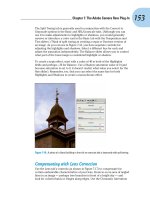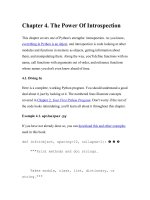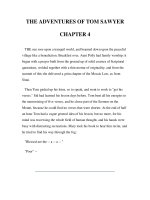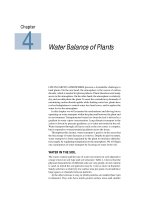Chapter 4 metabolism of tag 2015819
Bạn đang xem bản rút gọn của tài liệu. Xem và tải ngay bản đầy đủ của tài liệu tại đây (734.58 KB, 40 trang )
Fatty Acid Biosynthesis
• Fatty acid are synthesized and degraded by different
pathways
– from acetyl CoA
– in the cytosol
– intermediates are attached to the acyl carrier
protein (ACP)
– the activated donor is malonyl–ACP
– reduction uses NADPH + H+
– stops at C16 (palmitic acid)
Reactivity of Coenzyme A
(HSCoA)
Nucleophilic acyl substitution
O
CH3CSCoA
HY ••
O
CH3C
Y •• +
HSCoA
Acetyl coenzyme A is a source of an acetyl
group toward biological nucleophiles(it is an
acetyl transfer agent)
Formation of Malonyl Coenzyme A
Formation of malonyl–CoA is the committed
step in fatty acid synthesis
Formation of Acetyl ACP and Malonyl
ACP
• The intermediates(acetyl-ACP and malonyl-ACP) in
fatty acid synthesis are covalently linked to the acyl
carrier protein (ACP)
– To start an elongation cycle, Acetyl–CoA and
Malonyl–CoA are each transferred to an acyl
carrier protein
O
||
CH3—C—S—ACP ( Acetyl-ACP)
O
||
-O—C—CH2—C—S—ACP (Malonyl-ACP)
Condensation and Reduction
In reactions 1 and 2 of fatty
acid synthesis:
• Condensation by a synthase
combines acetyl-ACP with
malonyl-ACP to form
acetoacetyl-ACP (4C) and
CO2 (reaction 1)
• Reduction converts a ketone
to an alcohol using NADPH
(reaction 2)
Dehydration and Reduction
In reactions 3 and 4 of
fatty acid synthesis:
• Dehydration forms a
trans double bond
(reaction 3)
• Reduction converts the
double bond to a single
bond using NADPH
(Reaction 4)
Lipogenesis Cycle Repeats
Fatty acid synthesis continues:
• Malonyl-ACP combines with
the four-carbon butyrylACP to form a six-carbonACP.
• The carbon chain lengthens
by two carbons each cycle
Lipogenesis Cycle Completed
• Fatty acid synthesis
is completed when
palmitoyl ACP
reacts with water to
give palmitate (C16)
and free ACP.
Elongation and Unsaturation
• Endoplasmic reticulum systems introduce double
bonds into long chain acyl–CoA's
– Reaction combines both NADH and the acyl–
CoA's to reduce O2 to H2O
• convert palmitoyl–CoA to other fatty acids
– Reactions occur on the cytosolic face of the
endoplasmic reticulum.
– Malonyl–CoA is the donor in elongation reactions
Summary of Fatty Acid Biosynthesis
The synthesis of TAG
1. Mono-acylglycerol pathway (MAG pathway)
(for dietary fat digestion and absorption)
CH2OCOR
CHOCOR
CH2OCOR
TAG
pancreatic
lipase
FA
CH2OCOR
CHOCOR
pancreatic
lipase
CH2OH
DAG
FA
CH2OH
CHOCOR
CH2OH
MAG
intestinal lumen
FA
FA
ATP,CoA
acyl CoA
acyl CoA
CH2OH
CHOCOR
CH2OCOR
CHOCOR
CH2OCOR
TAG
Chylomicrons
CH2OH
MAG
intestinal epithelium
lymphatic vessels
adipose tissue
2. Diacylglycerol pathway (DAG pathway)
(for TAG synthesis of in adipose tissue, liver and kidney)
glucose
CH 2OH
liver
adipose tissue
CO
NADH+H+
liver
kidney
ATP
ADP
NAD+ CH 2OH
CH2OH
CHOH
CHOH
phosphoglycerol
glycerol kinase
dehydrogenase
CH 2O-PO 3H2
CH2OH
CH 2O-PO 3H2
dihydroxyacetone
phosphate
glycerol
3-phosphoglycerol
RCO¡« SCoA
acyl CoA transferase
HSCoA
CH 2OCOR
HSCoA
CHOCOR
CH 2OCOR
triacylglycerol
RCO¡« SCoA CH 2OCOR
CHOCOR
Pi
H2 O
CH 2OCOR
HSCoA RCO¡« SCoA
CHOH
CHOCOR
CH 2OH
phosphatase CH 2O-PO 3H2
acyl CoA
transferase diacylglycerol
phosphatidate
CH 2OCOR
acyl CoA
transferase
CH 2O-PO 3H2
lysophosphatidate
Catabolism of TAG
Ketosis
In normal metabolic pathway, acetoacetate and bhydroxybutyrate are the ketone bodies which are
converted to acetyl - CoA. However, during starvation
and in uncontrolled diabetes, conc. of acetoactate is very
high and supply of oxaloacetate (a TCA component) is
insufficient,
thus
acetoacetate
spontaneously
decarboxylated to acetone - KETOSIS
A 4-carbon acid (oxaloacetate) is needed to react with excess
acetyl-CoA and form citrate
When OAA is not available, excess acetyl - CoA in liver are
condensed to form ketone bodies
OAA is limited during scarcity of glucose for glycolysis. In starvation
and diabetes, glycogen is broken down. Fatty acids of fat depots
are metabolized to supply ATP needs producing excess of the
ketone bodies
Ketone Bodies
Most of the acetyl-CoA product during fatty acid oxidation is utilized
by the citric acid cycle or in isoprenoid synthesis. In a process called
ketogenesis, acetyl–CoA molecules are used to synthesize
acetoacetate, b-hydroxy butyrate and acetone, a group of molecules
called the ketone bodies
Ketone body formation occurs within mitochondria
Ketone bodies are used to generate energy by several
Tissues, e.g., cardiac and skeletal muscle and brain
Ketone Body Formation
Oxidation of ketone bodies
in brain, muscle, kidney, and intestine
NAD+
NADH
-Hydroxybutyrate
Acetoacetate
-Hydroxybutyrate
dehydrogenase
CoA
2 Acetyl CoA
Succinyl CoA synthetase = loss of GTP
Thiolase
Succinyl CoA
CoA transferase
Acetoacetyl CoA
Succinate
Citric
Acid
Cycle
Conversion of Ketone Bodies to
Acetyl-CoA









